What is a studio apartment?
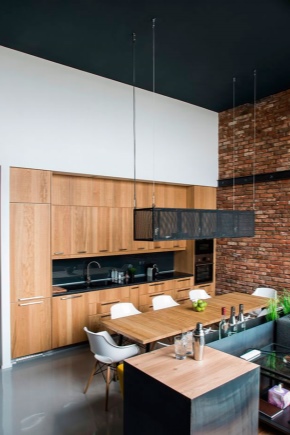
Studio apartments are becoming more and more popular. Those who buy or rent such a living space are faced with its peculiar features. Some of them, for example, the lack of doors, take a long time to get used to, while others, such as open space, on the contrary, allow you to quickly appreciate the advantages of an unusual layout.
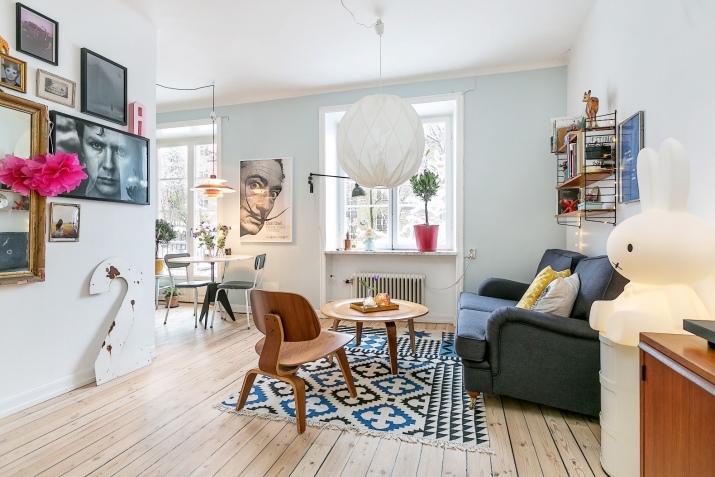

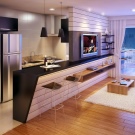

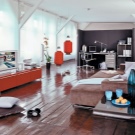

What is it and how is it different from a one-room apartment?
A studio apartment is an apartment without internal partitions and walls that would delimit the space. In fact, it is a single living space, which is allotted simultaneously for the bedroom, and for the living room, and for the kitchen. The only fenced room in the studio is the bathroom and toilet.
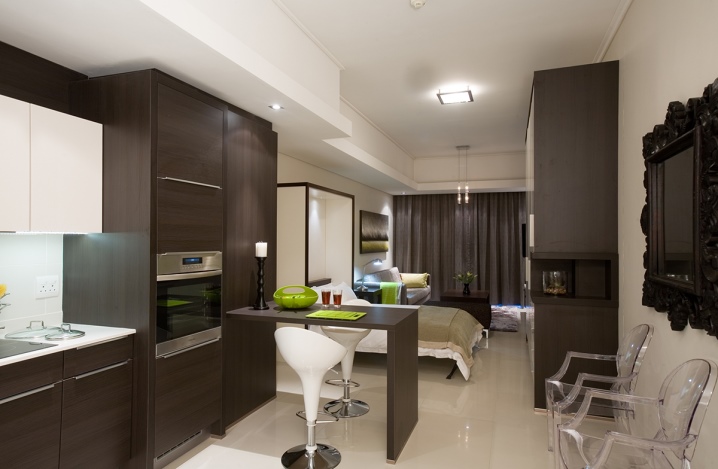
Studio apartments have appeared in Japan, where there is a problem of lack of space in megacities. People who work in large cities, and at the same time have large main housing outside its borders, equipped small apartments with only the most necessary. They had a place to live during the working week and at the same time not waste time traveling out of town or to other cities.
The USA took the fashion for studio apartments. First of all, such housing was intended for young people who could not afford something more, and creative bohemians, realizing their potential in design. After that, this type of layout began to be used by architects from Europe and Russia.
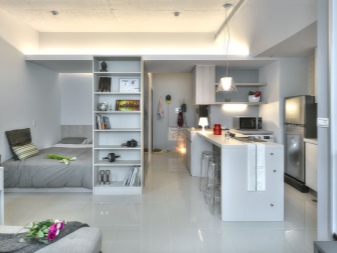


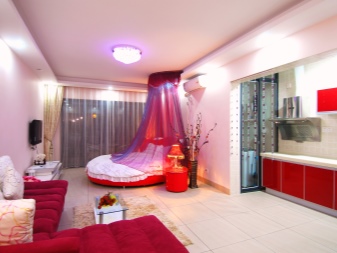
In the basic building codes, rules and standards, there is no precise definition of this type of living space, however, its main difference from a one-room apartment is precisely the absence of its division into zones by partitions and doors. Recall: even one-room apartments can have a corridor and a kitchen, separated by walls, while in studios they are not initially provided.
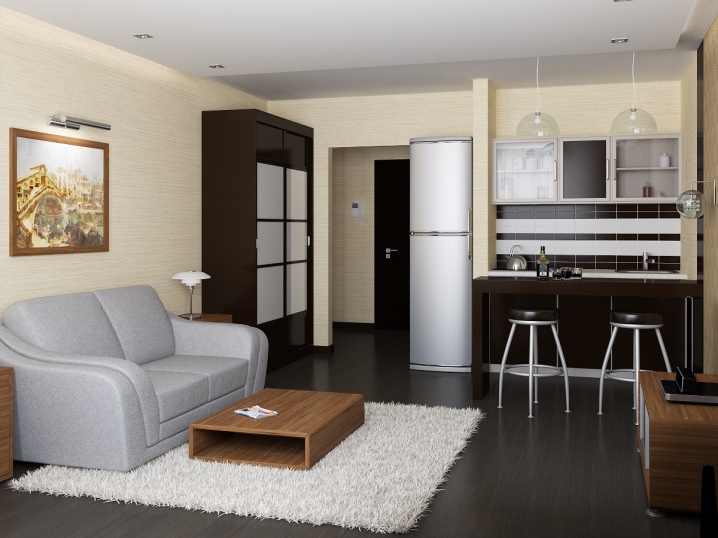
Advantages and disadvantages
The main advantage of studio apartments is their lower price compared to one-room apartments. In addition, they are often charged lower utility bills. This is due to the small size of the room and its more efficient use.

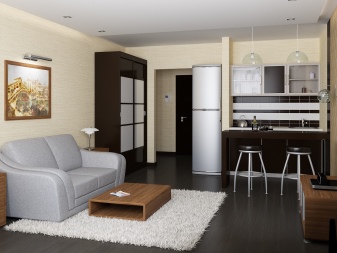
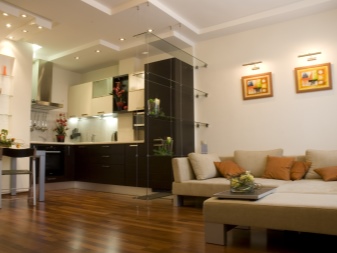
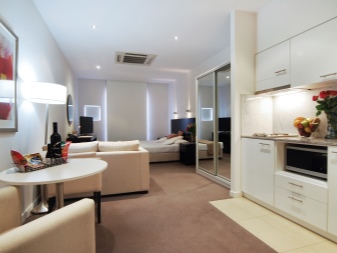
However, the small size is also the main disadvantage. Ordinary economical studios often do not contain all the things the owners need. To store them, the owners often rent separate warehouses, but this affects additional costs and inconvenience. To use a small space more ergonomically, you have to think over the layout to the smallest detail.
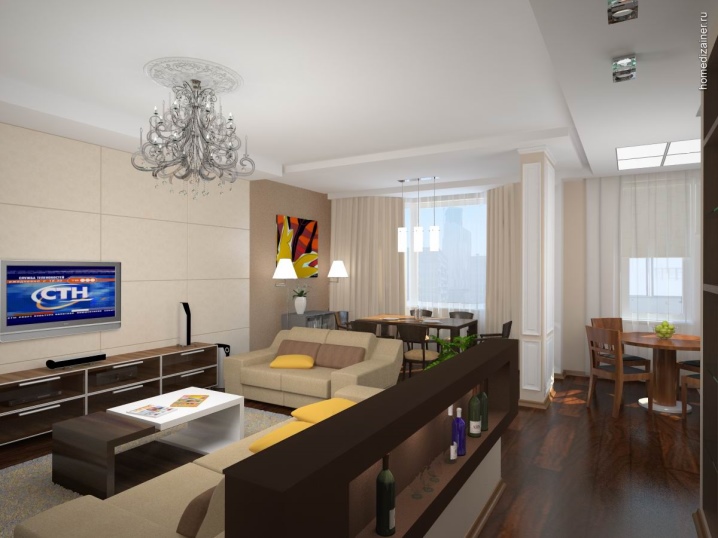
Another undoubted plus is mainly large windows, the light from which is enough for the entire apartment. That is, there is no need to use additional lighting during daylight hours. In an open space, sound waves are better distributed, which will be a great help for musicians or home theater lovers.
A plus can be called the atmosphere that the studio apartment carries. For young people, such a living space is imbued with the spirit of independence and freedom. Creative individuals find self-expression in the arrangement of an apartment or in turning it into a studio. Wealthy people demonstrate their status thanks to a modernly equipped large apartment.



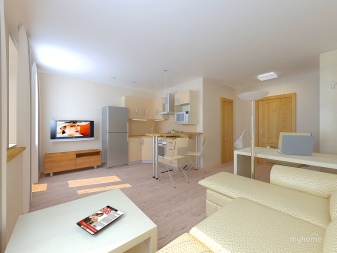
Among the disadvantages is the lack of a hallway that would hold back the dust and dirt brought from the street in the same room.The lack of a partition between the kitchen area and the bedroom can become a problem if the ventilation system in the apartment is outdated or not powerful enough, since odors will fill the entire room.
On the other hand, the absence of boundaries between the kitchen and the living room makes the room more comfortable for holding festive dinners.
The sleeping area is on display for all guests and visitors of the apartment, which often violates personal space.
In addition to smells from the kitchen, other unpleasant odors can easily spread throughout the apartment, especially if there is a pet in the apartment.
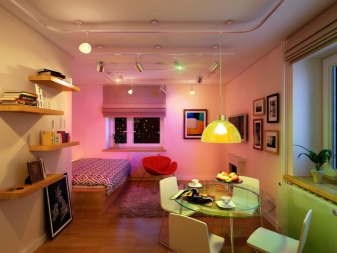
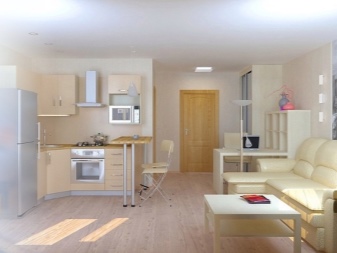

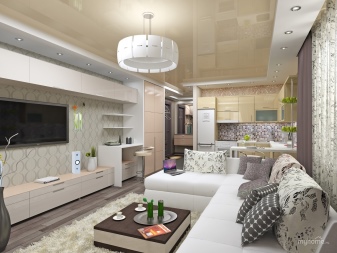
The negative side is that drafts can walk through the studio if there is a balcony in the room.
Lack of confidentiality will be a disadvantage for those who do not live in an apartment alone. If the need for privacy is important, fenced areas should be considered in the layout.
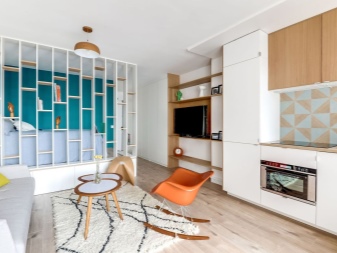
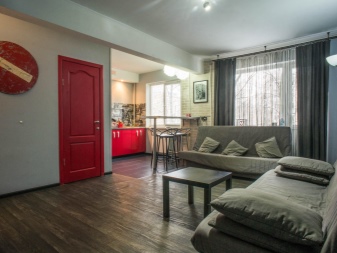
Several drawbacks appear at once if an ordinary apartment is converted into a studio. This is due to the need for inspections and permits from the authorities, redevelopment, dismantling of walls and floors, alteration of the power supply system, and sometimes water supply. All this takes not only a lot of time, but sometimes so large expenses that they are comparable to buying a full-fledged studio, and not remodeling an existing living space.
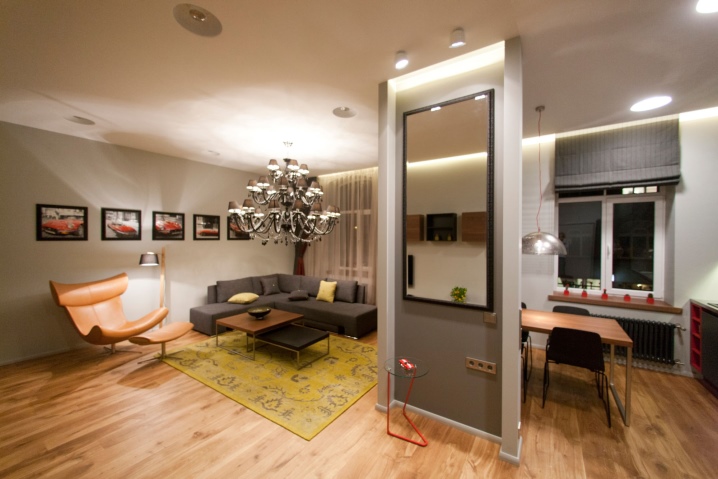
Views
There are several options for the appearance of studio apartments:
- the layout provided by the original building design. This type of apartment is becoming popular, therefore it is present in the types of houses in different price categories. In economy dwellings, these are small studios suitable for a family of two, students, single people. In luxury homes, they can be large and even occupy the penthouse area.
- redevelopment of ordinary multi-room apartments. Most often they are made from one-room and, less often, two-room apartments, in which partitions between the bedroom and the kitchen are specially removed. This can be done only with the permission of special services and bodies, such as the Ministry of Emergency Situations, the department of architecture, the bureau of technical inventory. At the same time, there are several prohibitions that do not allow redevelopment, which relate to the demolition of load-bearing walls, the transfer of risers, and a reduction in the area of the bathroom and loggia.
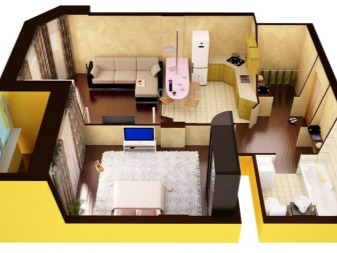
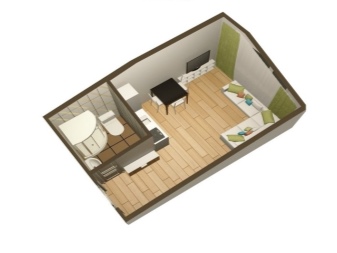
Often there are two-story and even three-story studio apartments, in which zones and rooms are separated from each other by tiers and stairs.

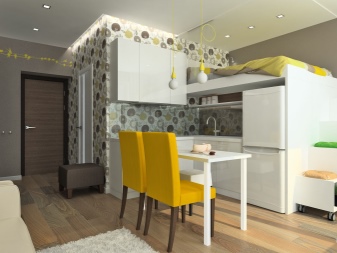
The most common are standard rectangular and square studio apartments, but often architects use different, sometimes arbitrary configurations in their projects. There are dwellings in the shape of a triangle, trapezoid, oval.
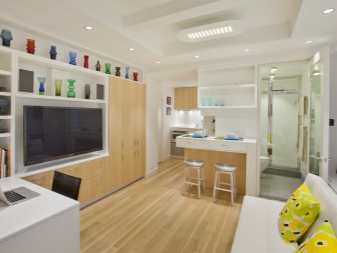
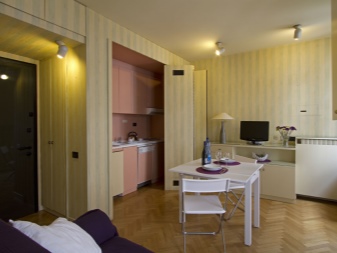
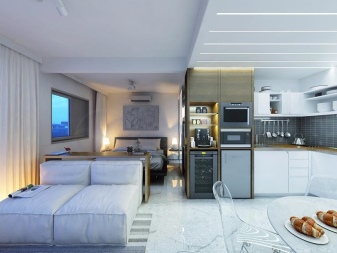

Styles
Great attention is paid to the design arrangement of studios so that the free space looks harmonious and in the same style. Owners can either turn to the help of professionals or independently design the apartment.
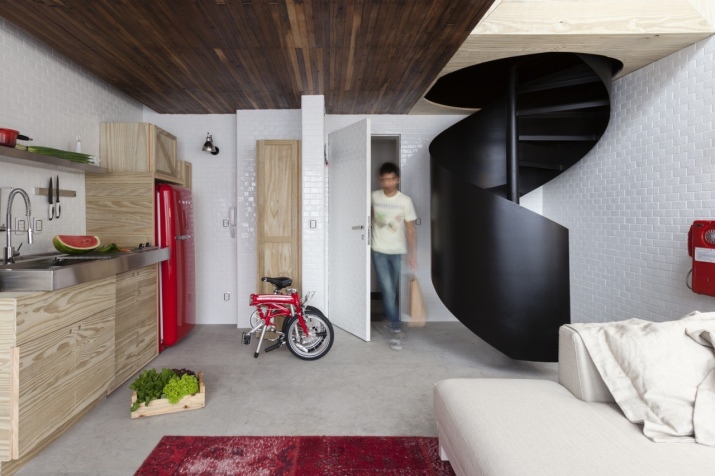
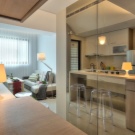
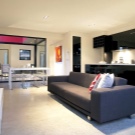

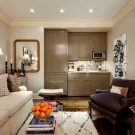
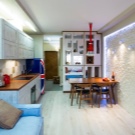
Among the stylistic trends, there are several that are especially popular and relevant for studios. These are predominantly modernist trends, as they look most relevant in modern studio apartments. However, design is possible in more classical and ethnic styles, but more often than not a single space is not enough to fully reflect them.
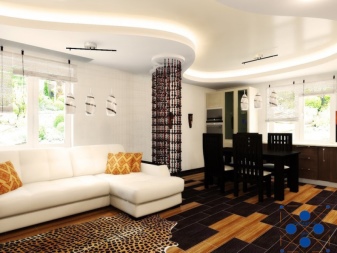
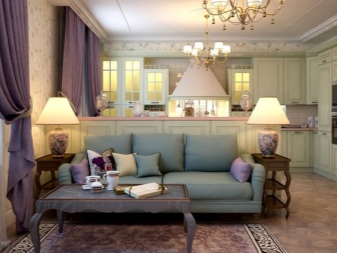

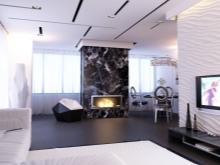
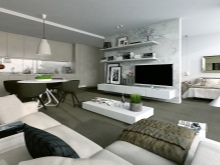
Industrial modern is one of the most minimalist and austere styles. Due to the use of concrete, metal and wood textures, the interior looks a little rough, but completely satisfies the spirit of modern urbanism. Items that imitate old and vintage things are used. With its raw walls, ceiling and floor, the industrial apartment resembles a factory.
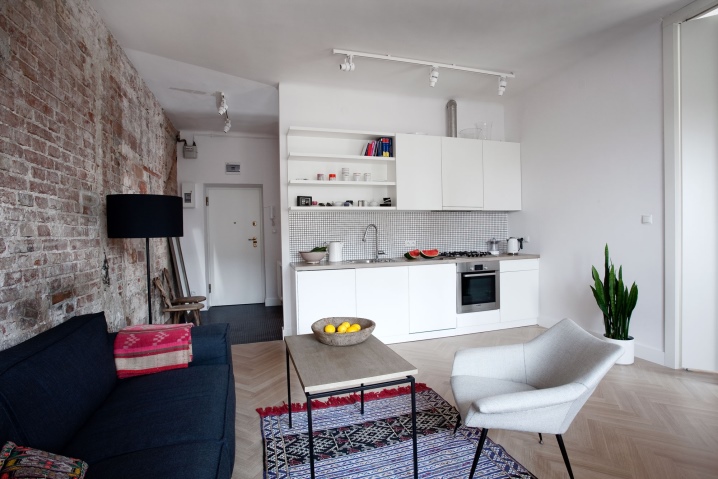
It involves the use of predominantly dark "natural" scales. Brown, brick, gray, as well as white, rusty, black are the most common. The use of small bright accents is also allowed.As for the decor, it should have an overall minimalist character in the industrial modern style. Particular attention is paid to lighting, since with a lack of it, an apartment can evoke frightening emotions.
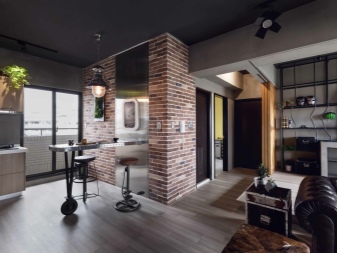
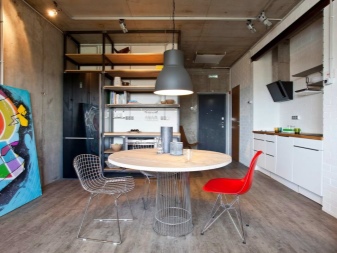
Similar to industrial and loft style, which is also called "attic". It combines antiquity and innovation, simplicity and, at the same time, antique pathos. As in the previous one, in this style preference is given to natural wall textures, brick or wallpaper with a similar pattern is especially popular. In the direction of the loft, much attention is paid to decorative details that create a single concept. It is considered a favorite style of creative people, so many art objects, wall paintings, figurines, and bold chandeliers are used as decorations.
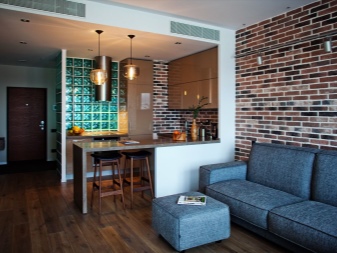



The opposite of the previous two styles is Provence. It is a little more luxurious, although it is simple in its own way, since it also uses imitation of antiquity. The main difference is the color scheme - it is predominantly white, delicate pastel. Materials such as natural textiles and lace, sewing, ceramics, porcelain are used as decoration and details. A characteristic feature is the purchase of wooden or wicker furniture, including those with forged details, and floral patterns are often found on soft upholstery.
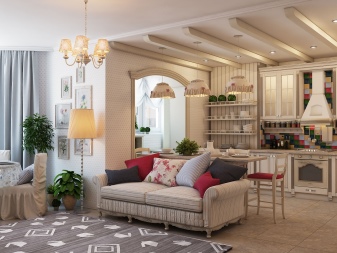
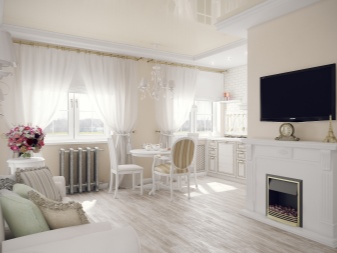
The fusion style proposes to combine conservatism with futurism, and also act in the direction of maximalism. The main idea is the absence of any framework and rules. This affects the fact that in one room a combination of various details is used, which at the same time add up to a harmonious composition. The prevailing materials are natural stone, leather, linen, canvas and animal skins. Despite the combination of the incongruous, all interior items should not be placed chaotically and clutter up the space.
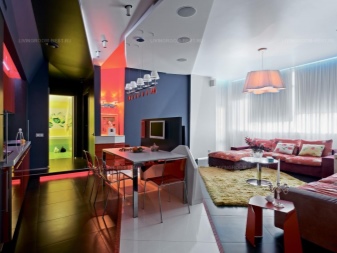
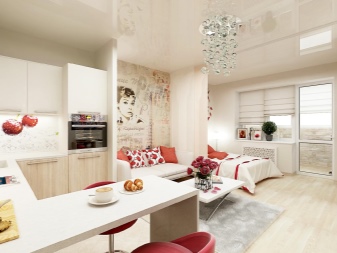
The fusion color scheme is designed in bright shades, for example, gold, crimson, turquoise, combined with the basic ones. As an interesting solution, spot lighting is used over especially spectacular places in the interior, while often all the lamps are different from each other. The furniture is classic, with gold or silver finishes. Fusion style requires draped curtains and curtains, numerous pillows, carpets.

The Art Deco style is romantic, sophisticated and even luxurious. It combines elements of constructivism and culture of Egypt, Africa, Mesopotamia, Ancient Greece. Aluminum and stainless steel are combined with exotic leather, enamel, ivory, rare wood, stained glass. The decor uses animalistic, geometric, ethnic and floral motifs. The color palette is bright and often contrasting.
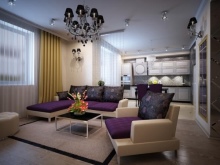
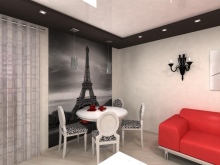
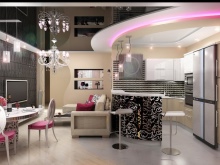
Another popular French style is boho, which is often translated as "gypsy". This is one of the brightest and most flashy directions, in which everything is sustained in one color scheme, but at the same time combines elements of other styles in the decor.
Decorations in the interior carry a semantic load, as they should reflect the interests of the owner, but at the same time high-tech items should be completely absent. Wood, textiles, and stone are chosen as the main materials. The color scheme is predominantly natural, and, in general, an abundance of plant decoration or flowers is necessary.
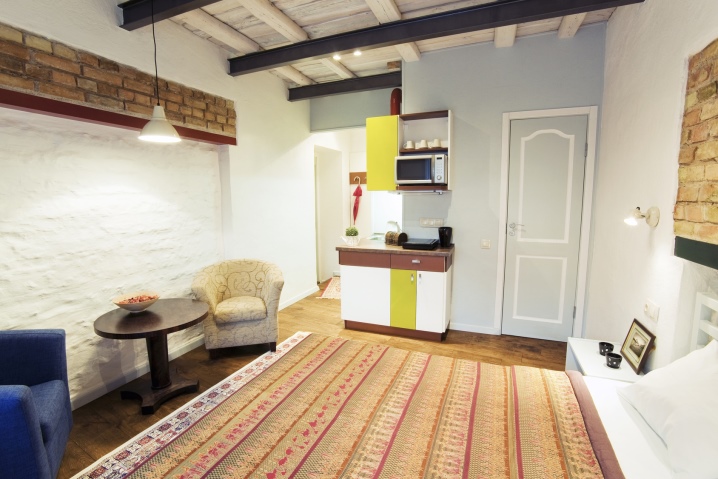
Layout and zoning options
The layout of a studio apartment can be divided into several types:
- in the open one there are no partitions, and the visual separation is created by the furniture. The space is used most functionally, but it is almost impossible to retire in such a studio, which makes it convenient for living alone or together. The bathroom and the bathroom are the only rooms that are separated from the common space, but this is also a completely optional rule;
- in a closed area, all zones are separated from each other by partitions or walls without doors.In such an apartment there will be a personal place for each resident, but an already small area will be reduced by transitions and dividers;
- in the combined one a sleeping place or an office is separated from the common room. It is believed that this is the most optimal option, since a single partition almost does not take up free space, while allowing you to retire in one of the rooms.
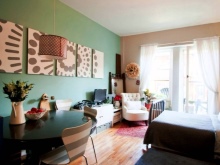
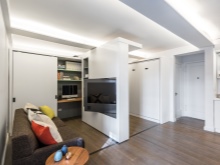
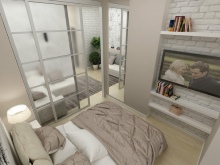
In a studio apartment, areas such as a bedroom, kitchen, workplace, living room or a place for relaxation are usually allocated. In total, there are two types of space zoning:
- The first is constructive, using real partitions and walls.
- The second is visual.
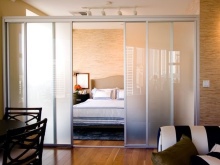
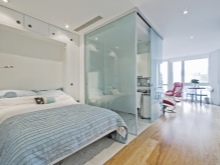
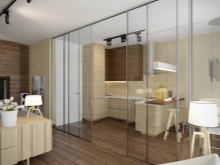
In constructive zoning, decorative partitions are often used, since it is much easier to place and move them than walls. They can be both ceiling-high and half human height. It is more difficult to create a partition with an arch or sections of walls for the entire area from scratch, but they are easy to implement in the case of redevelopment of an ordinary apartment or a room in a communal apartment. Curtains, screens, sliding doors are much more popular.
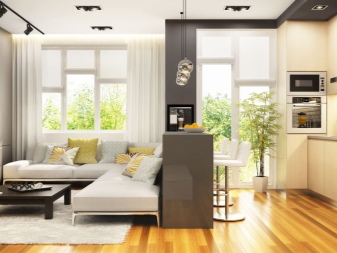
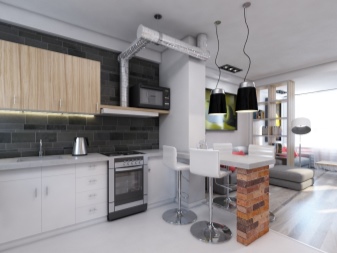
If the studio apartment has high ceilings, then you can divide the room into zones using several tiers. For example, make an "attic" bed or resting place by lifting them up to the ceiling. In order to save space under the upper tier, there is a workplace, an extra bed or wardrobes.
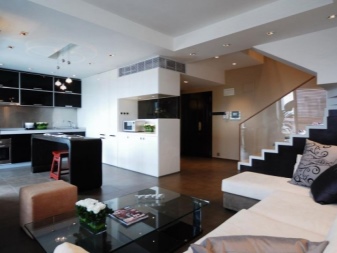
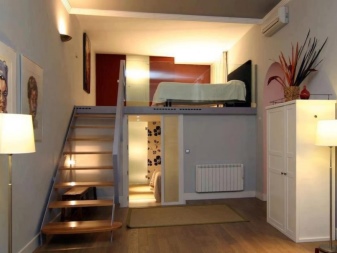
Visual zoning does not clutter up the space with walls, doors, curtains. Its main technique is the use of different finishes and textures, as well as podiums and different levels of stretch ceiling. You can also divide the space with the help of furniture, for example, by turning the bed with its back to the living room or by separating the hallway from most of the room with a wardrobe.
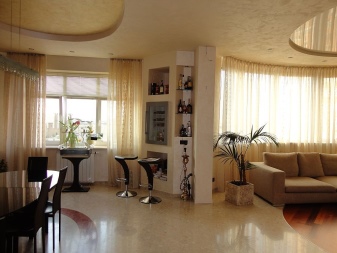
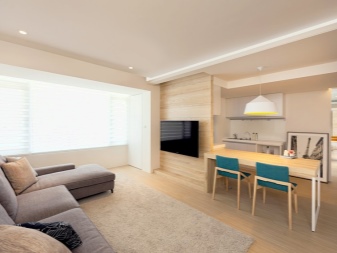
It is possible to delimit the zones of the studio by relying on the number of windows. In an apartment with two windows, it is really possible to make a closed layout without any problems, highlighting, for example, a bedroom and a living room one by one. With panoramic windows, it is preferable to make an open or combined layout, since there is only one large source of natural light in the room.
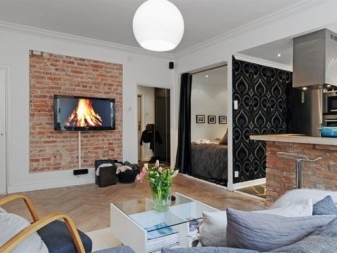

Studios with balconies are not uncommon. The presence of additional space gives new opportunities in the layout of the apartment. The balcony can either perform its usual role or be a separate full-fledged area, for example, a bedroom or a resting place.
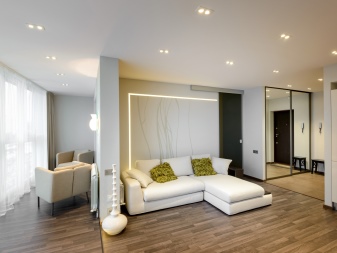
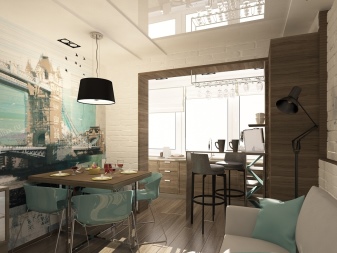
How to equip: finishing options and furnishings
Before proceeding with the arrangement of the apartment, you should clearly understand which of its parts will be given to this or that zone.
A compact area should be allocated for the kitchen and, if the apartment has a small footage, make the most of the space. This can be done with the help of small kitchen sets, which have many tiered drawers. You can also use small appliances: mini- or low-rise refrigerator, two-burner stove and with a built-in oven. Multifunctional items will also help, for example, multicooker, microwave oven.
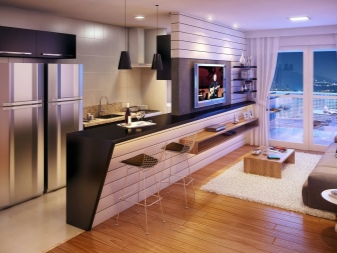
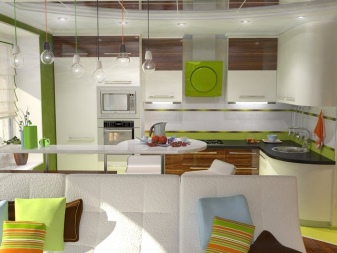
In a studio apartment, a powerful hood is vital, otherwise the odors will spread throughout the entire area. The kitchen can gradually move into the dining or dining area. To save space, you can use folding tables attached to the wall or bar counters, which serve as a visual partition between zones.
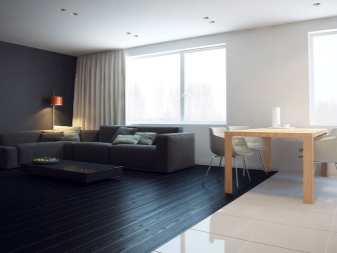
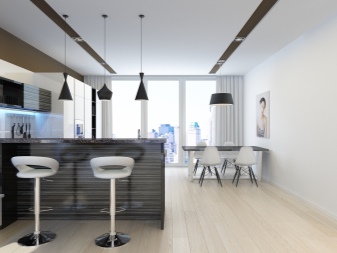
The sofa can differentiate the living room from other areas and become the centerpiece of the chosen style. It can be a minimalistic low model, light with a pile of pillows. If there are guests in the house, you can put a sofa that can be used in an extra bed.

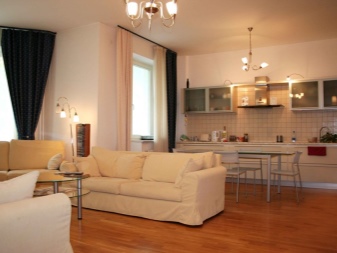
An excellent solution would be to use other transforming furniture in the apartment. In the bedroom, these can be beds rising to the wall or hiding in the closet, and in the living room, sliding or prefabricated screens.
In small apartments, it is best to use furniture that performs several functions at once. For example, it can be a bed with pull-out cabinets, a hollow ottoman for storing linen or other things. Appliances can be built into shelves or hung on the wall, for example, a TV with a turntable or game console.
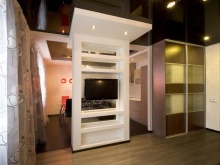
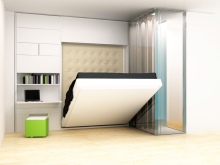
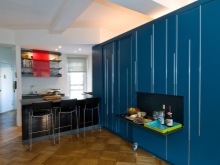
There are some tricks that allow you to either delimit the space, or make it visually larger. Thin curtains should be used to create a feeling of lightness. Floor mirrors on the wall or wardrobes will create the illusion of more space. The window sill can be converted into a work or dining table, and the low ones can be converted into a resting place.
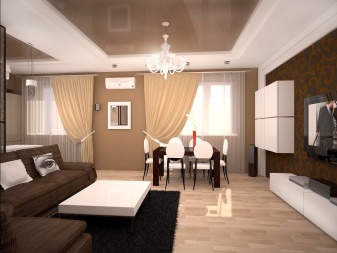
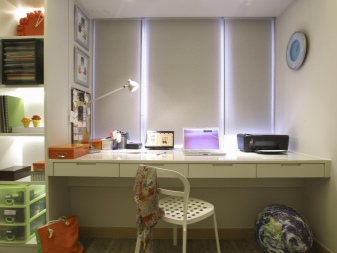
The design is complete only in the harmony of furniture and the fundamental parts of the apartment - floor, wall, ceiling. Both in open and closed layouts, they can be designed in the same color scheme or in different ones, separating the zones from each other. Walls can be painted, made of drywall, or covered with wallpaper. Some styles allow for a complete lack of decoration on the walls.
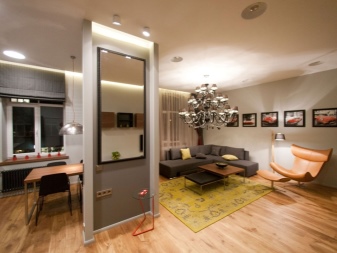
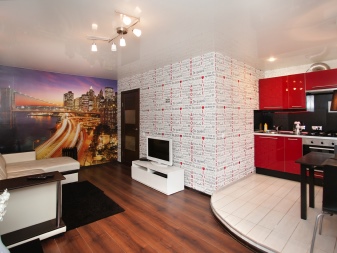
Stretch ceiling of different heights will visually separate the zones from each other. In addition, it allows the use of compact spots that do not take up extra space like lamps.
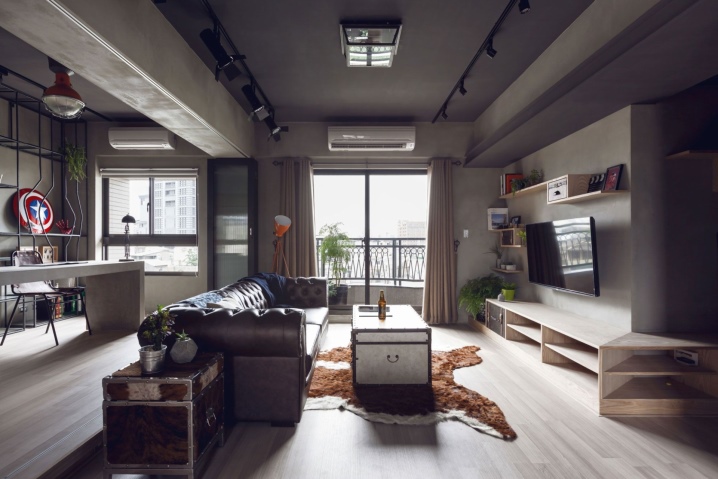
The balcony can be equipped with kitchen utensils, exercise equipment, a sofa with pillows, and your own greenhouse. And if you put a corner table, you get an equipped dining area.
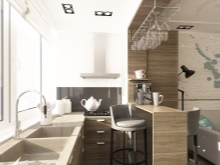
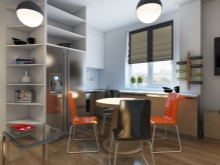
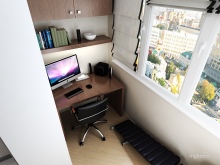
Designers advise using furniture in a minimalist style with straight lines so that the silhouette looks even and uniform, not cluttered. However, the choice should primarily depend on the preferred style.
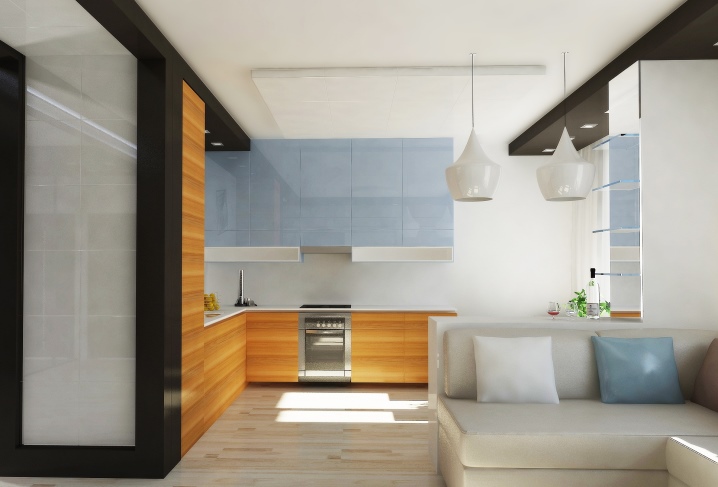
Color and decor
The color scheme should be treated with caution, as it can both increase the space and make it more loaded. There are large windows in the apartment, then dark colors are also allowed, but if the room is very limited and there is little lighting, it is better to use a white or pastel palette. Beige, light blue, sand and other delicate shades will visually make the room more spacious and fresh.
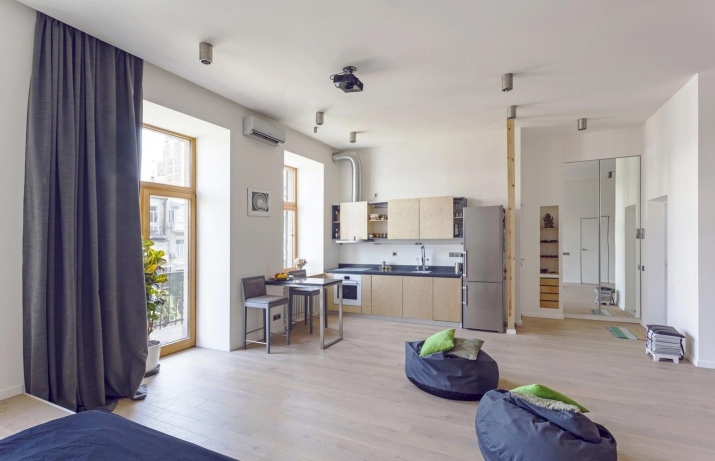

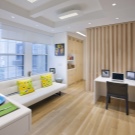
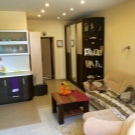
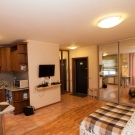

With a contrasting combination of colors, for example, black and white, white and red, you can create visual accents. They are useful if there is a desire to highlight some object from the overall harmonious interior, for example, a sofa, an intricate carpet or an original painting.
The color scheme is an effective zone delimiter. So the studio can be made in a single palette, but each of the "rooms" has its own accents and prominent spots.
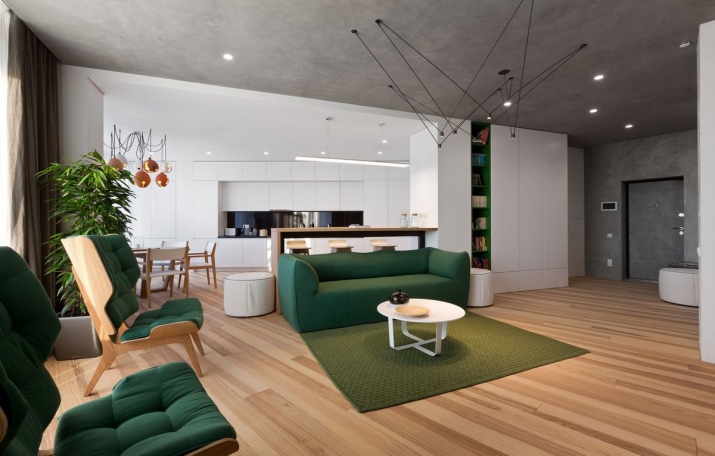
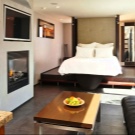
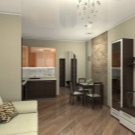
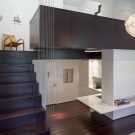
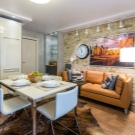
Experts advise using as little decor as possible so as not to overload a small room. However, often in different styles, for example, boho, the use of a large number of decorative elements is simply necessary. In their choice, one should adhere to one concept. It is best if the decor will not take up a lot of floor space, such as large vases and statues. The priority is for decorations that fit into the overall furnishings - paintings and posters on the walls, figurines on the shelves.



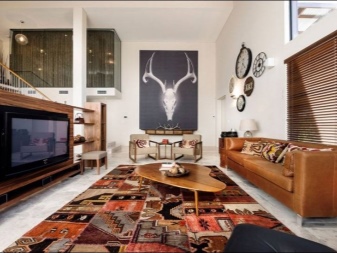
Despite the presence of a window, the light from which is enough for the entire space, it is still dark in the parts farther from it. A kitchen is most often located there, but, regardless of the zone, you should take care of the lighting in advance. It is best to use lamps in the white spectrum, as it is close to natural. In small studios, it is better to use ceiling and wall lamps, but if there is free space, then floor lamps can also be placed there.

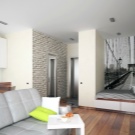
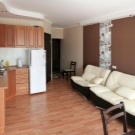
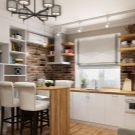

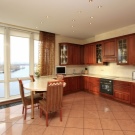
Beautiful ideas in the interior
A combined layout with sliding doors separates the sleeping area from the living room. It breaks a single picture and the use of different colors: in the sleeping area it is beige and white, in the guest area it combines rich blue, brown and gray. Wall boxes are located above the large double bed, in which it is convenient to store sleeping clothes.The living room uses a folding coffee table, an open bookcase with shelves, mirrors on the walls.
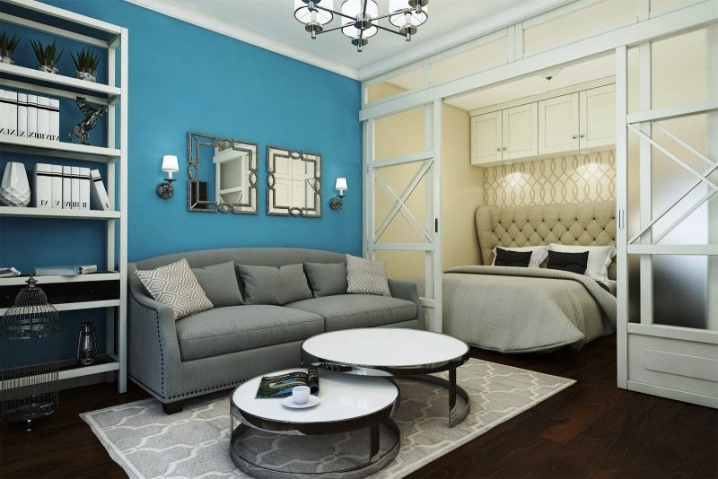
Two-tiered space delimitation significantly saves space. An open corridor is created by partitions, behind which there is a kitchen area and niche shelves for TV and decor items. The “attic” area was occupied by a bedroom with an additional shelf.
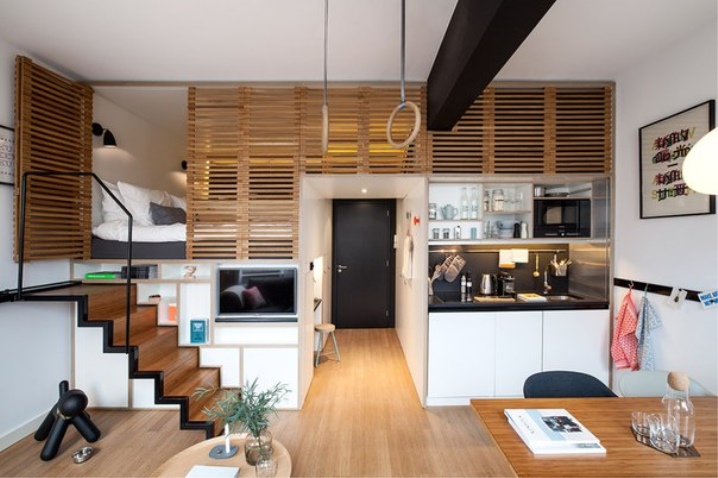
The living room is combined with the dining room due to the presence of a dining table. The free space allowed for a pull-up exercise machine to be hung from the ceiling. The color scheme is designed in white and natural wood shades.
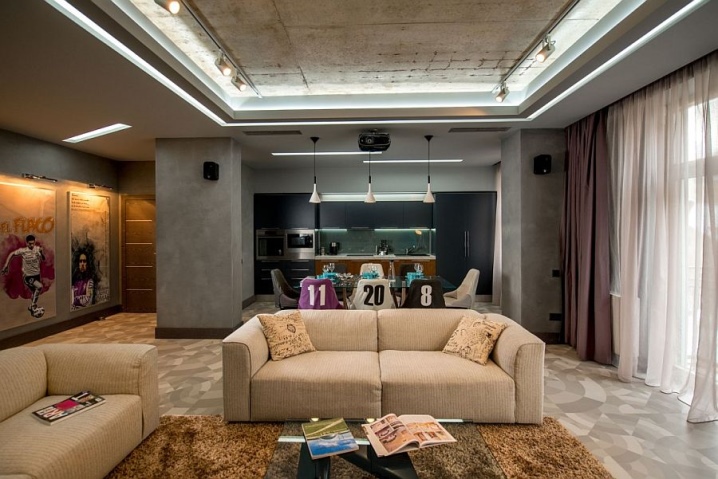
Minimalistic design in a beige and gray palette. Each area of the interior has its own main color shades - gray in the kitchen, beige and sand in the living room. Differentiation is also created by different levels of ceilings. The bright soft carpet in the living room and posters on the walls in the hallway are used as bright color accents.
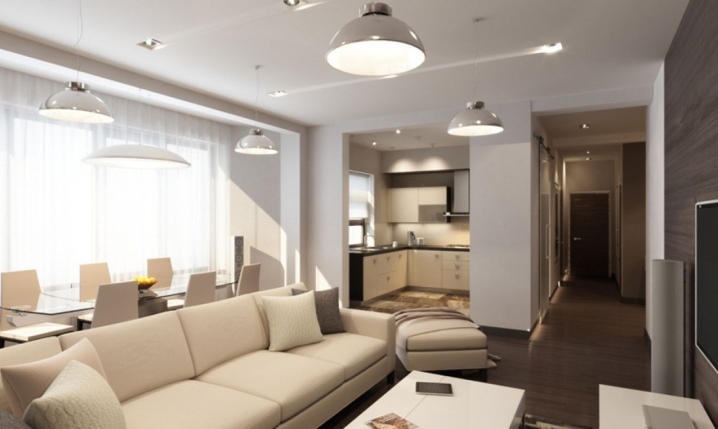
The open plan kitchen blends seamlessly into the living room with a dining table and chairs. The curtain with light sheer and dense curtains creates a contrast that makes the overall composition more profound.
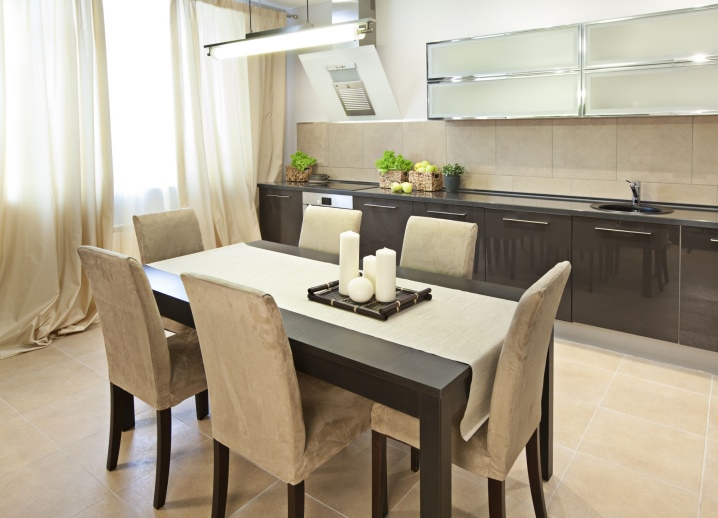













The comment was sent successfully.